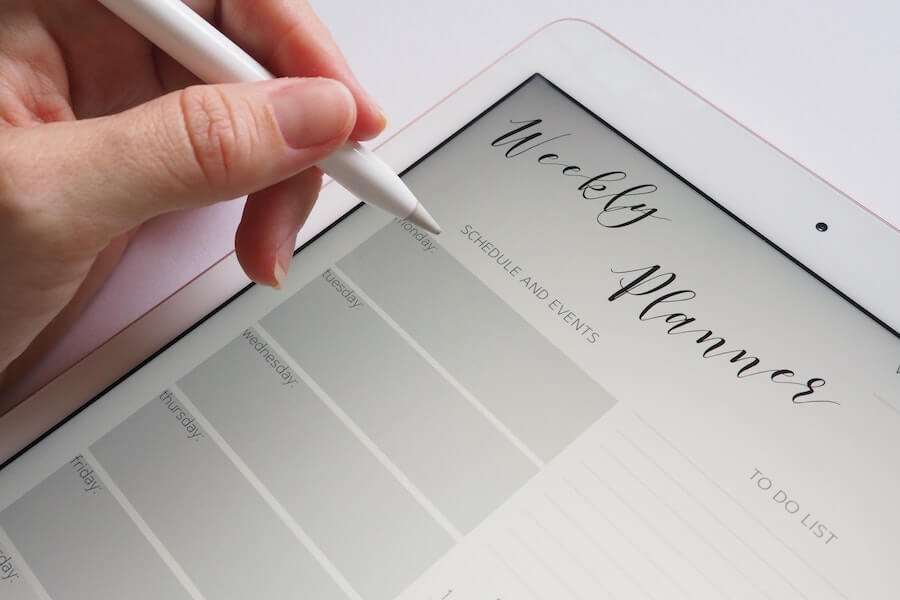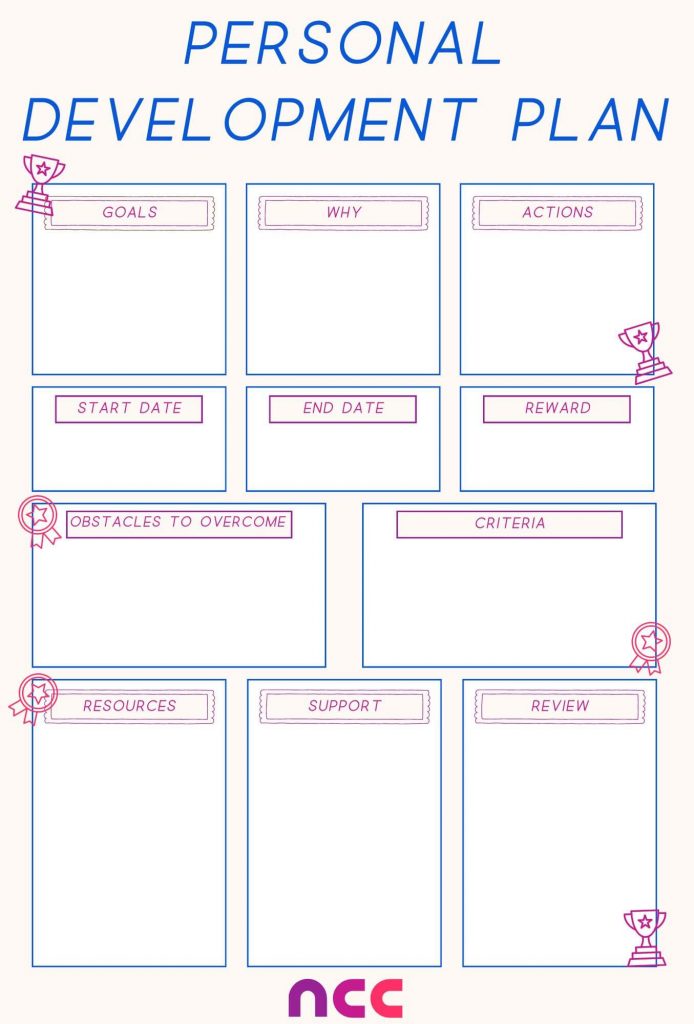Do you need help with the direction of your personal growth? A personal development plan can help!
This planning technique will allow you to gain clarity and focus on your personal and professional goals. In this article, we’ll explore how to write a personal development plan and provide you with a personal development plan template to get you started.
- What Is A Personal Development Plan?
- What Is A Personal Development Plan Used For?
- What Are The Benefits of Creating A Personal Development Plan?
- How To Write A Personal Development Plan
- 1. Identify Your Reason
- 2. Complete A SWOT Analysis
- 3. Make SMART Goals
- 4. Prepare For The Future
- Personal Development Plan Template
- 5 Examples of Personal Development Goals
- Creating A Personal Development Plan Your Way
- FAQs
- Resources
What Is A Personal Development Plan?
First of all, precisely what is a personal development plan?! A personal development plan (PDP) is a structured framework to help people identify and achieve their personal and professional goals. At its core, a PDP is a written document that outlines a person’s strengths, weaknesses, areas for improvement, and the steps they plan to take to reach their goals.
By identifying their strengths and weaknesses, individuals can use a personal development plan to become more self-aware and better understand their abilities. This can help them identify the skills they need to develop and the resources they need to acquire to achieve their goals.
A typical personal development plan example includes several sections, such as an assessment of current skills and competencies, a list of personal and professional goals, an action plan for achieving those goals, and a timeline for tracking progress.
Read More: What Is Personal Development?
What Is A Personal Development Plan Used For?

You can use a personal development plan for a variety of reasons. For example, you can improve your job prospects and advance your career or use it to develop new skills or pursue personal interests. Whatever you want to achieve, a personal development plan will help!
Here are some examples of situations when a personal development plan can help:
- Create a roadmap for personal and professional development.
- Prepare for job interviews and appraisals
- Enhance job prospects
- Increase chances of promotion or career advancement.
- Pursue personal interests and hobbies.
- Build confidence and self-esteem.
- Improve overall quality of life by setting and achieving meaningful goals.
What Are The Benefits of Creating A Personal Development Plan?
Assessing your strengths and weaknesses, setting goals, and creating a plan to achieve them can help you reap many benefits. Here are just a few:
- Increased self-awareness
- Better mental health
- Clearer goals
- Improved focus
- Increased motivation
- Enhanced skills and knowledge
- Better career prospects
How To Write A Personal Development Plan
Creating a personal development plan may sound like a tricky task, but once you’ve broken it down, it’s surprisingly easy – and fun! Here’s how to write a personal development plan in four simple steps:
1. Identify Your Reason
Before you jump into analysis and setting goals, you have to get to the core of what you want from your personal development plan. Essentially, you’re creating your mission statement for your project.
Identify why you’re creating a personal development plan. For example, if you want to train for a marathon to increase your fitness, your why isn’t specifically ‘I want to run a marathon’. Instead, it would be, ‘I want to exercise more to feel better in my body’.
2. Complete A SWOT Analysis
Businesses commonly complete a SWOT analysis to help them understand and focus their future proceedings, and this framework can be just as beneficial to you. SWOT stands for Strengths, Weaknesses, Opportunities and Threats, and companies complete this type of analysis to evaluate their current competitive position and strategically plan for the future. To use this in your personal development plan, you can identify your strengths, weaknesses, opportunities and threats to your goals.
Start by separating a piece of paper or digital spreadsheet into the four sections of SWOT. Then, fill them out as follows:
- Strengths – List areas where you excel, such as hobbies or skills you have developed.
- Weaknesses – Identify areas that might hold you back from achieving your goals. This could include habits like binge-watching TV or lacking the confidence to try new things.
- Opportunities – Note factors that can help you achieve your goals. These include external factors like a supportive environment or internal factors like a positive attitude.
- Threats – List potential obstacles that might prevent you from achieving your goals. These could be external factors like a lack of support from friends and family or internal factors like fear of failure.
3. Make SMART Goals

First, using your SWOT analysis, you can identify the kind of goals that you should aim to achieve. Then, with SMART goals, you’ll be able to form efficient mission statements that you can achieve.
But what are SMART goals? SMART stands for Specific, Measurable, Achievable, Relevant and Time, and these goals have specific, achievable objectives and time frames.
To break this down a bit, you have:
- Specific – You should clearly define your objective – avoid being vague or ambiguous.
- Measurable – Your goal should be measurable so that you can track your progress.
- Achievable – Your purpose should be challenging yet realistic.
- Relevant – Your objective should be relevant to your personal or professional goals.
- Time – You should anchor your aim in time, with a clear start and finish date.
So, rather than saying, ‘I want to run a marathon’, your SMART goal could be, ‘I want to complete online sports courses over six months to understand my training better’, or ‘I want to run at least 5 km twice a week for my first month of training’. The SMART goal is more achievable and will carry you seamlessly onto the next goal.
View more home learning courses to help you meet your personal development goals
4. Prepare For The Future
So, you know how to write a personal development plan. You have a mission statement you believe in, an in-depth analysis to inform your next steps and SMART goals you are willing to achieve. But, no matter your best efforts, life can quickly get in the way of your plan. So, you need to prepare for any hindrances.
Naturally, life changes, so it’s unfair to expect to include everything in your personal development plan. As such, be prepared to update and change your plan as you go – and know there’s no shame in this. You’re not giving up, just adapting.
In fact, reviewing your personal development plan often is best practice. Understanding that your goals and overall plan will likely change over time will help you accept your personal development as it happens rather than feeling as though you are off the path.
Personal Development Plan Template
To help you get on your way to achieving your goals, we’ve put together a simple personal development plan template. All you need do is download this template, print it out and fill it out to help you get started.

Here’s what each section of our personal development plan example means so you can fill it out to the best of your ability:
- Goals – What do you want to achieve with a personal development plan? What are your objectives?
- Why – Why do you want to achieve these goals?
- Actions – How are you going to achieve these goals? What do you have to do to get there?
- Start Date – When have you started your personal development plan?
- End Date – When do you want to have achieved your goals? Alternatively, you can fill this in after you have achieved your goals.
- Reward – What will be your reward once you have achieved your goals?
- Obstacles To Overcome – What obstacles will you come up against?
- Criteria – How will you know when you have achieved these goals?
- Resources – What resources will you need and have access to?
- Support – What support channels will you have?
- Review – Towards the end date of your personal development plan, you can note down how well you did in preparation for the next plan.
5 Examples of Personal Development Goals
Now you are armed with our personal development plan template and know how to write a personal development plan; it’s all up to you! However, getting to know and understand the goals you want to achieve can be daunting. For example, you may know that you want to get a promotion, but do you know the smaller goals that you will need to achieve to reach that milestone?
To help you make a personal development plan that will benefit you the most, here are some of the most common personal development goals that you may want to include in your plan:
Make Better Decisions
Improving your ability to make informed and effective decisions is a beneficial personal development plan goal, as it helps increase your confidence in decision-making and enhance your problem-solving skills. You can achieve this goal through various methods, including gathering relevant information, weighing up pros and cons, and seeking feedback from others.
Improve Time Management
Many of us could do with an extra hour or two in the day. However, with a personal development plan, you can maximise the time you do have so you don’t end the day feeling as though you could have done more. By focusing on time management, you can increase productivity, efficiency and punctuality and reduce procrastination, improving both your work and home life.
Work On Active Listening
Active listening is a skill that involves fully engaging with the speaker, understanding their message, and responding appropriately. Including this goal in a personal development plan can help you to develop stronger relationships with others, improve your communication skills, and gain a deeper understanding of people’s needs and perspectives.
Manage Stress
Stress can negatively impact both your physical and mental health, so learning how to manage it effectively is important for personal development. You can include this goal in a personal development plan to help you develop coping strategies and improve your overall well-being.
Improve Public Speaking Skills
Public speaking is a valuable skill that can help you communicate effectively in professional and personal settings. Including this goal in a personal development plan will help you to become a more confident and effective speaker, improving your communication skills and potentially opening up new opportunities for personal and professional growth.
Creating A Personal Development Plan Your Way

Congratulations! You’ve learned how to write a personal development plan and discovered the many benefits it can provide. By setting specific, measurable, achievable, relevant, and time-bound goals, you can create a roadmap for your personal and professional growth. Remember to regularly review and update your personal development plan as you progress to stay on top of your growth. The journey towards self-improvement begins with a single step, and you’ve already taken that first step by reading this article.
FAQs
What should be included in a personal development plan?
A personal development plan should include a clear set of goals and objectives, a plan of action to achieve those goals, and a timeline for reaching them. It should also include a list of your strengths and weaknesses and the skills and knowledge you need to develop to achieve your goals. Finally, it should include a plan for tracking your progress and evaluating your success.
What are the 5 areas of personal development?
The five areas of personal development are:
Emotional: Developing emotional intelligence and resilience, managing stress, and building positive relationships with others.
Intellectual: Enhancing your knowledge and skills, pursuing education and lifelong learning, and challenging yourself to think critically and creatively.
Physical: Taking care of your body through exercise, nutrition, and self-care.
Professional: Developing skills and knowledge for your career, setting career goals, and pursuing opportunities for growth and advancement.
Spiritual: Exploring your values and beliefs, connecting with a higher power or purpose, and cultivating a sense of inner peace and fulfilment.
Resources
Mind Tools Content Team. (2021, March 25). SMART Goals – How to Make Them Achievable. Mind Tools. https://www.mindtools.com/a4wo118/smart-goals [accessed 01/06/23]








